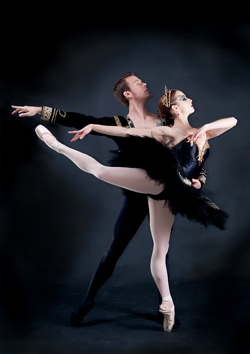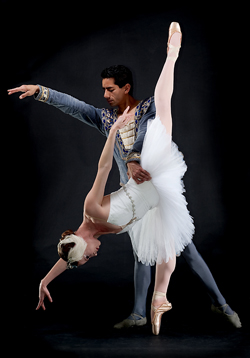Samuelsson as White Swan with Gerardo Gil as a Prince in City Ballet production
of Swan Lake {Photos: Dale Stokes}
By Sheila Orysiek
SAN DIEGO — The “Tchaikovsky Spectacular” performance on March 6 by City Ballet of San Diego in the Spreckels Theatre, was a full plate of dance; over two hours with only one intermission. That the Company can sustain this feast – and then some – is to be celebrated.
Swan Lake – Act II: The first notice goes to the corps de ballet – an indication of the ever growing depth of artistic maturity. Every head, foot, and hand moved with one mind. The crossing voyagés were even in height and solid while the details within details such as nuanced epaulement were exemplary. However, I think they would have profited from a larger stage – they certainly deserve it. From the four cygnets to the three “big” swans and to everyone in between: “Brava!”
Von Rothbart (Kyle Rivieccio) opened the Lake scene with his huge bat wings. Though he moves about the empty stage as its owner, he doesn’t convince that he possesses it. The lake is his and the swans therein – he is the font of the magic, but that gleeful, malevolent possession is missing. It’s not a matter of opening and closing the wings – it’s a matter of presentation and the arrogance of power. He needs to grow it. Von Rothbart is an important character – the nexus to the story – and difficult to portray.
The Odette/Odile role is often described as a duality of person – the opposite sides of a coin. But it is much more; it isn’t two roles, it is four. Odette is swan/woman and Odile is evil sent to destroy good. Thus she must show the veneer of womanly virtue covering the seductress beneath. She is both Odile and Odette.
Ariana Samuelsson’s Odette takes us on the journey from swan to woman to swan; making visible her initial hesitancy, her growing trust, her embrace of the woman within and then her grief stricken reluctance as she is forced to return to Von Rothbart. Gerardo Gil’s Siegfried – except for his support of the ballerina – has very little individual dancing of his own. Perhaps in the future that existing beautiful adage solo for the male dancer (a rarity in the ballet repertoire) will become part of the Company’s production of this ballet. Or Elizabeth Wistrich could choreograph another. What Gil does he does well – but he needs more.
Janica Smith’s Odile needs to add a surface softness on top of Odile’s hard core (layers) otherwise why would Siegfried be fooled and fall in love with her? When Siegfried tries to kiss her hand, she snaps it away a tad too quickly and thus instead of a false idol she becomes a brat. The audience sees the seductress, but Siegfried needs to see Odette. The pas de deux took fire with her spot on fouettés, every fourth one a double. John Henry Reid (Siegfried) caught her fire and responded in kind. But why the black tights against a black back drop? White, gray or silver are just as royal.
The joy of live music was ably supplied by the City Ballet Orchestra under the baton of John Nettles.
Wistrich’s choreography for “Tchai Celebration” uses twelve piano pieces by Tchaikovsky; representing the months of the year. Six young musicians joined the dancers on stage behind but not hidden by narrow scrolls of cloth which changed height from the stage floor with each “month.” The music was dreamy and the costuming simple but effective – suited to the mood of each piece; tunics, diaphanous skirts, unitards, to black and gold dresses.
The Company can field a growing number of men on stage who dance well together as well individually. It is interesting to see that when turning as a group each goes to his favored (right/left) side. Gerardo Gil was splendid in “July” as was Megan Jacobs as “November.” Wistrich’s choreography, while innovative, never gives the sense of senseless innovation – it is impelled by the music. It doesn’t ever become gymnastic and doesn’t forget this is a performance of dance not an exhibit of false wit.
I think one of the most revealing moments was at the very end when the stage filled with the dancers taking their bows – each in the costume of the “month” they had danced and it became obvious the continuing growth of artistic maturity throughout the Company’s roster.
John Nettles led the Bunnell Strings with Nina Deering at the piano.
*
Sheila Orysiek is a San Diego-based dance critic. She may be contacted at sheila.orysiek@sdjewishworld.com


